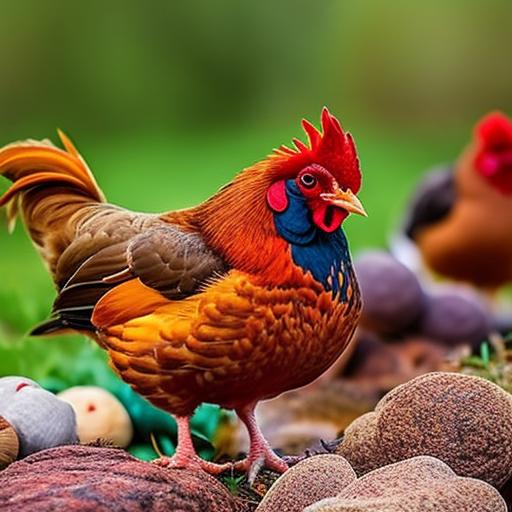Chickens are sensitive to cold temperatures and need a warm and cozy environment to stay healthy and happy. Just like humans, chickens can suffer from the effects of cold weather, including frostbite and respiratory issues. Providing warm bedding in their coop helps to insulate the space and keep the chickens comfortable during the winter months.
When chickens are exposed to cold temperatures, their bodies have to work harder to maintain their core temperature. This can lead to stress and a weakened immune system, making them more susceptible to illness. By providing warm bedding, you create a barrier between the cold floor of the coop and the chickens’ bodies, helping to maintain a more stable temperature.
Key Takeaways
- Warm bedding is important for chickens to maintain their health and comfort during the winter months.
- The ideal temperature range for chicken coops is between 50-70°F.
- Choosing the right bedding material for your chicken coop depends on factors such as absorbency, insulation, and availability.
- Straw is a popular bedding option for chicken coops due to its affordability and insulation properties.
- Sand is a natural bedding material that can help control moisture and odor in the coop.
The Ideal Temperature Range for Chicken Coops
The ideal temperature range for chicken coops is between 50-70 degrees Fahrenheit. Temperatures below 50 degrees can cause health problems for chickens, such as frostbite on their combs and wattles. It can also lead to respiratory issues if they are constantly exposed to cold air.
On the other hand, temperatures above 70 degrees can lead to heat stress in chickens. They are not able to regulate their body temperature as efficiently as mammals, so they rely on external factors like shade and ventilation to cool down. If the coop becomes too hot, it can be detrimental to their health.
Choosing the Right Bedding Material for Your Chicken Coop
There are several different types of bedding materials to choose from when it comes to providing warmth for your chickens. Some popular options include straw, hay, wood shavings, sand, and fleece blankets. The right bedding material will depend on your personal preferences, budget, and the needs of your chickens.
Straw is a popular bedding option for chicken coops because it is affordable, readily available, and easy to clean. It provides good insulation and helps to keep the coop warm and dry. However, straw can be dusty, so it’s important to monitor the air quality in the coop and make sure it doesn’t become too dusty for the chickens.
Hay is another bedding option for chicken coops that provides good insulation and helps to keep the coop warm and dry. It is more expensive than straw but is also softer and more comfortable for chickens to nest in. Hay can also be used as a source of food for chickens, as they enjoy pecking at it and it provides some nutritional value.
Wood shavings are a common bedding material for chicken coops because they are absorbent and help to control odors. They are also easy to clean and provide good insulation. However, it’s important to use shavings that are specifically made for animal bedding, as some types of wood can be toxic to chickens.
Sand is a natural bedding material for chicken coops that is easy to clean and helps to control odors. It provides good drainage and helps to keep the coop dry. Sand is also a great option if you have chickens that like to dust bathe, as they can easily dig into the sand and keep themselves clean.
Fleece blankets are a soft and cozy bedding option for chickens that provide good insulation and comfort. They are more expensive than other bedding materials but can be reused and are easy to clean. Fleece blankets are especially beneficial for older or injured chickens that may need extra warmth and cushioning.
Tips for Maintaining Warm Bedding in Your Chicken Coop
To maintain warm bedding in your chicken coop, it is important to clean it regularly and replace it when it becomes wet or soiled. Wet bedding can lead to mold growth and ammonia buildup, which can be harmful to your chickens’ respiratory health.
You can also add extra insulation to the coop by using draft stoppers around doors and windows. This will help to prevent cold air from entering the coop and keep the warm air inside. Another option is to cover windows with plastic during the winter months to create an additional barrier against the cold.
It’s also important to monitor the temperature in the coop and make adjustments as needed. If the temperature drops below 50 degrees, you may need to provide additional heat sources such as heat lamps or heated pads. However, it’s important to use these with caution and follow safety guidelines to prevent fire hazards.
Keeping Your Chickens Cozy and Comfortable All Winter Long
By choosing the right bedding material and maintaining it properly, you can keep your chickens cozy and comfortable all winter long. Remember to monitor the temperature in the coop and make adjustments as needed to ensure that your chickens stay healthy and happy.
Providing warm bedding is just one aspect of creating a suitable environment for your chickens during the winter months. It’s also important to provide adequate ventilation, access to fresh water, and a balanced diet to support their overall health and well-being.
Taking care of your chickens’ needs during the winter will not only ensure their comfort but also contribute to their productivity. Happy and healthy chickens are more likely to lay eggs consistently, which is a benefit for those who keep chickens for their eggs.
So, invest in warm bedding materials, maintain cleanliness in the coop, and monitor the temperature regularly. Your chickens will thank you with their contentment and productivity throughout the winter season.
If you’re looking for the best bedding to keep your chickens warm, you might also be interested in checking out this article on Poultry Wizard’s website. They have a great resource on snaplock chicken coops, which not only provide a secure and cozy shelter for your feathered friends but also offer insulation to keep them warm during colder months. You can find more information about snaplock chicken coops and other helpful tips for keeping chickens at https://poultrywizard.com/keeping-chickens/snaplock-chicken-coop/.
FAQs

What is the best bedding for keeping chickens warm?
The best bedding for keeping chickens warm is straw, hay, or wood shavings. These materials provide insulation and help to retain heat.
How thick should the bedding be?
The bedding should be at least 2-3 inches thick to provide adequate insulation for the chickens.
How often should the bedding be changed?
The bedding should be changed at least once a week to maintain cleanliness and prevent the buildup of harmful bacteria.
Can I use newspaper or cardboard as bedding?
Newspaper and cardboard are not recommended as bedding for chickens as they do not provide adequate insulation and can become slippery when wet, increasing the risk of injury.
What should I do if the bedding gets wet?
If the bedding gets wet, it should be removed and replaced with dry bedding to prevent the chickens from getting cold and developing respiratory problems.
Can I use sand as bedding?
Sand can be used as bedding, but it does not provide insulation and can become damp, increasing the risk of respiratory problems. It is best to mix sand with other bedding materials for better insulation.
Should I add any supplements to the bedding?
Adding supplements such as diatomaceous earth or herbs like lavender can help to repel pests and keep the coop smelling fresh. However, it is important to research the supplements and their effects on chickens before adding them to the bedding.
Meet Walter, the feathered-friend fanatic of Florida! Nestled in the sunshine state, Walter struts through life with his feathered companions, clucking his way to happiness. With a coop that’s fancier than a five-star hotel, he’s the Don Juan of the chicken world. When he’s not teaching his hens to do the cha-cha, you’ll find him in a heated debate with his prized rooster, Sir Clucks-a-Lot. Walter’s poultry passion is no yolk; he’s the sunny-side-up guy you never knew you needed in your flock of friends!







